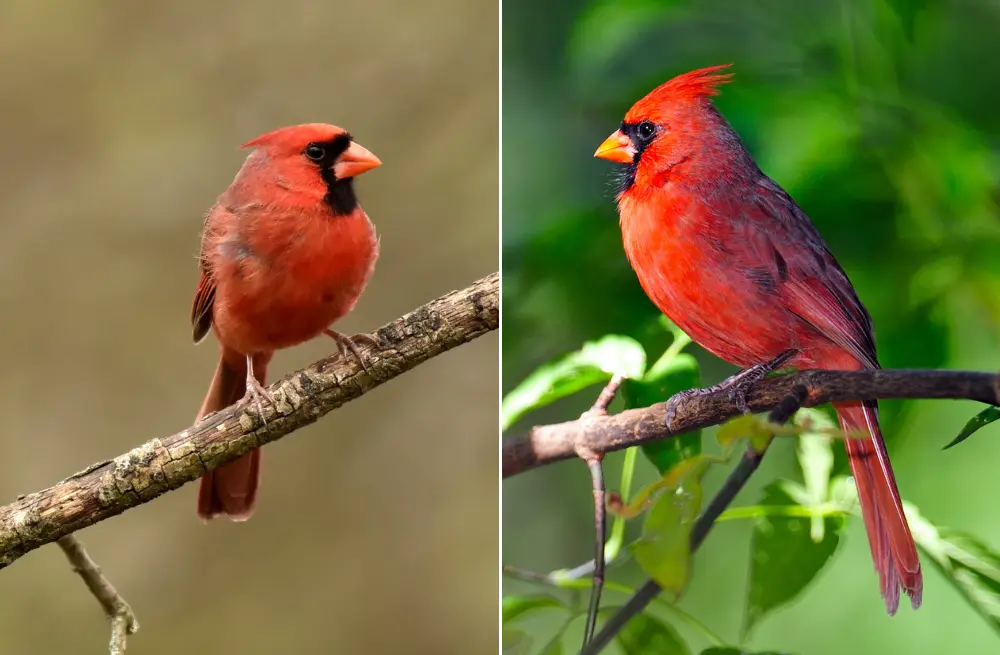Michigan, a land of diverse ecosystems and abundant wildlife, is home to a remarkable array of owl species.
From the iconic Great Horned Owl to the elusive Northern Saw-whet Owl, these majestic birds captivate both novice and seasoned birdwatchers alike.
In this article, we’ll delve into the enchanting world of owls in Michigan, discussing the various species that call this state home and revealing some of the best places to spot them.
What kind of owl lives in Michigan?
Michigan is home to a variety of owl species. Some of the owl species that can be found in Michigan include:
- Great Horned Owl (Bubo virginianus)
- Snowy Owl (Bubo scandiacus)
- Barred Owl (Strix varia)
- Eastern Screech Owl (Megascops asio)
- Barn Owl (Tyto alba)
- Northern Saw-whet Owl (Aegolius acadicus)
- Long-eared Owl (Asio otus)
- Northern Pygmy Owl (Glaucidium californicum)
- Northern Hawk Owl (Surnia ulula)
- Burrowing Owl (Athene cunicularia)
- Western Screech Owl (Megascops kennicottii)
- Flammulated Owl (Psiloscops flammeolus)
- Short-eared Owl (Asio flammeus)
These owl species have varying habitats and behaviors, making Michigan a diverse state for owl enthusiasts to explore and observe these fascinating birds.
Owling Tips: To enhance your owl-spotting adventures in Michigan:
- Know the Species: Learn about native owls in your area, their habits, and habitats.
- Learn Owl Calls: Recognize owl calls using guides or apps.
- Timing Matters: Go owling at dawn or dusk when owls are active.
- Scout Locations: Research owl-friendly spots like woodlands or urban areas.
- Use Red Light: Avoid startling owls with a red flashlight.
- Patience: Be patient and quiet during your search.
- Dress Warmly: Stay cozy during nighttime outings.
- Binoculars and Camera: Bring binoculars and a camera for distant shots.
- Respect Wildlife: Keep a respectful distance from owls and their nests.
- Join a Birding Group: Consider birding groups for guidance.
- Record Your Observations: Note sightings, dates, times, and behavior.
- Safety First: Inform someone of your plans for safety.
13 Owl Species in Michigan
Michigan’s diverse landscapes and rich ecosystems make it an ideal habitat for a wide range of owl species.
Whether you’re an avid birder or just fascinated by these enigmatic creatures, Michigan offers a unique opportunity to observe and appreciate these magnificent birds.
Here i’ll introduce you 13 owl species that can be found in the Great Lakes State and reveal some of the best places to encounter them.
1. Great Horned Owl (Bubo virginianus)
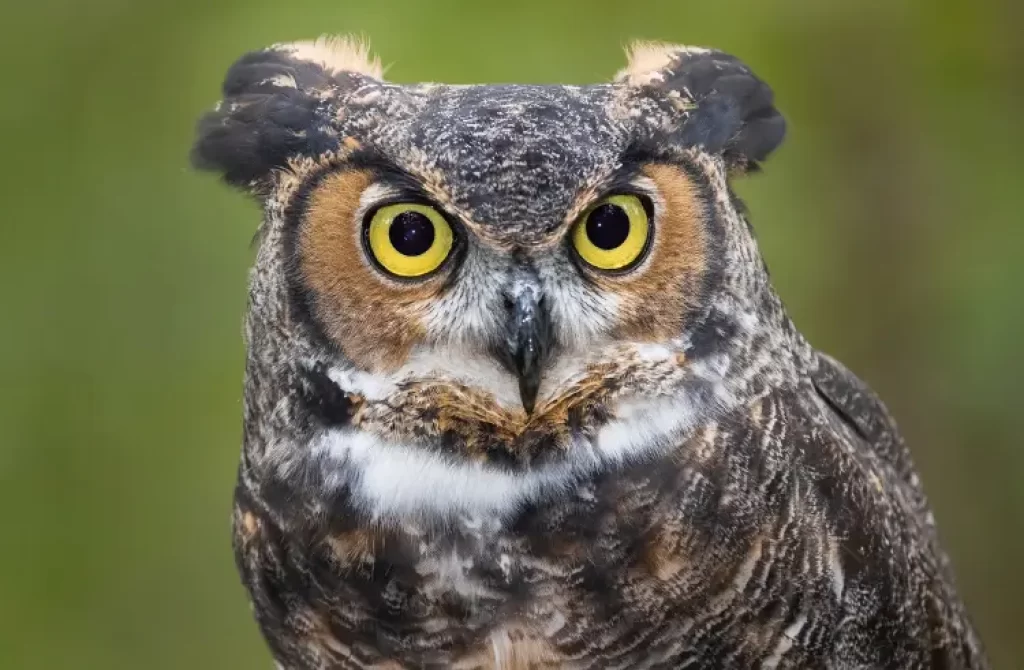
The Great Horned Owl, Michigan’s largest and most widespread owl species, graces the state’s diverse landscapes with its majestic presence. Recognizable by its striking tufted “horns,” which are actually feather tufts, and its resonant hooting calls that echo through the night, this owl is a true emblem of Michigan’s wilderness.
These adaptable raptors can be found in a variety of habitats, from dense woodlands and expansive forests to unexpected urban areas. Their remarkable versatility in habitat selection enables them to thrive in both natural and human-altered environments.
With a wingspan that can reach up to 60 inches, the Great Horned Owl is a formidable predator. Its mottled brown to gray plumage provides superb camouflage as it patiently awaits its prey, which includes small mammals, birds, and occasionally, other owls.
Notably, the Great Horned Owl faces no significant conservation concerns in Michigan, making it a common sight for those who venture into the state’s great outdoors. So, whether you’re exploring remote woodlands or wandering through urban parks, keep an eye out for this iconic Michigan owl.
2. Snowy Owl (Bubo scandiacus)
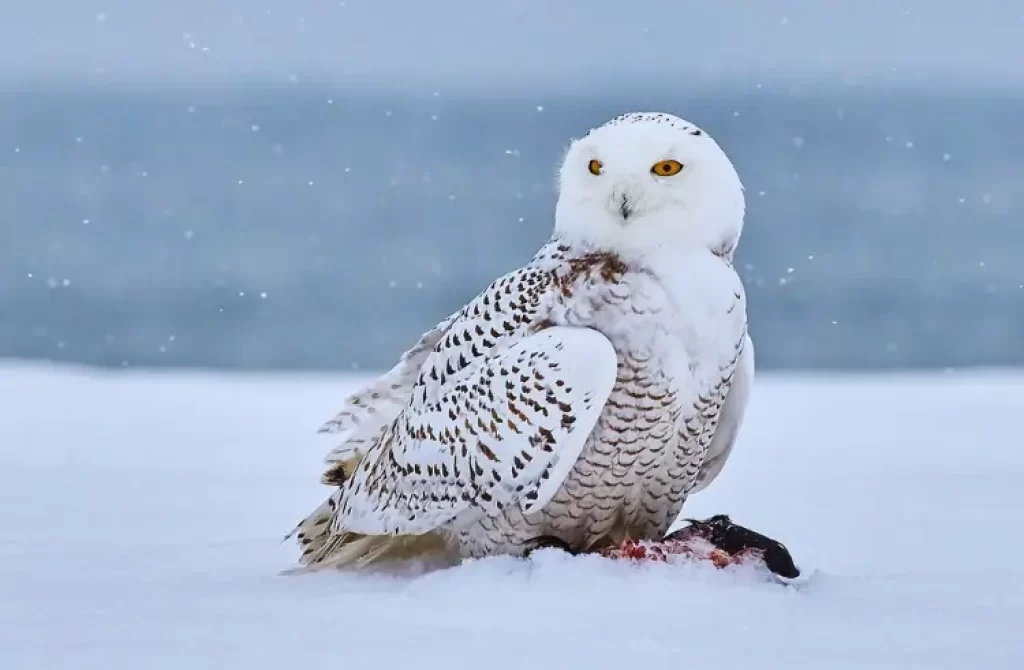
The Snowy Owl, with its captivating and distinctive appearance, stands as one of Michigan’s most iconic winter visitors. Cloaked in striking white plumage, these magnificent birds bring a touch of Arctic elegance to the state during the winter months.
When it comes to choosing their winter abode in Michigan, Snowy Owls have a penchant for the picturesque landscapes along the Great Lakes shoreline. These expansive regions, particularly around Saginaw Bay and Lake St. Clair, become their preferred hunting grounds.
For bird enthusiasts and nature lovers, encountering a Snowy Owl amidst its snowy habitat is an awe-inspiring and unique experience. With its characteristic white plumage contrasting against the winter landscape, spotting a Snowy Owl can be a true winter wonder.
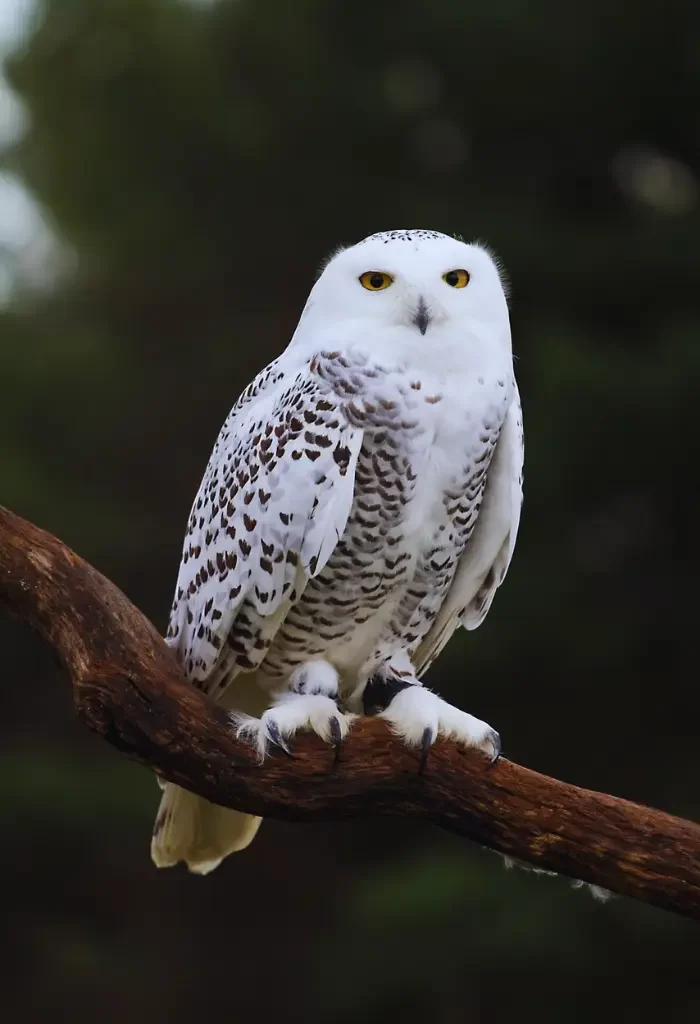
To increase your chances of spotting one of these Arctic visitors, bring along a pair of binoculars and keep your eyes peeled during your winter explorations.
The sight of a Snowy Owl perched majestically is a reward for those who embrace the cold and venture to these scenic regions during the colder seasons.
It’s essential to note that Snowy Owls are seasonal visitors to Michigan, making their stay during the winter months. As the weather warms, they will return to their Arctic breeding grounds, leaving behind a trail of wintertime memories for lucky observers.
😉 Snowy owls in Michigan are often found in regions like the eastern Upper Peninsula and the northern Lower Peninsula, where they favor open spaces like fields and shorelines for hunting.
Observing Snowy Owls in their natural habitat is an unforgettable experience that showcases the captivating beauty of Michigan’s winter wildlife. So, bundle up, explore the Great Lakes shoreline, and keep your camera at the ready to capture the magic of these Arctic guests in the heart of winter.
3. Barred Owl (Strix varia)
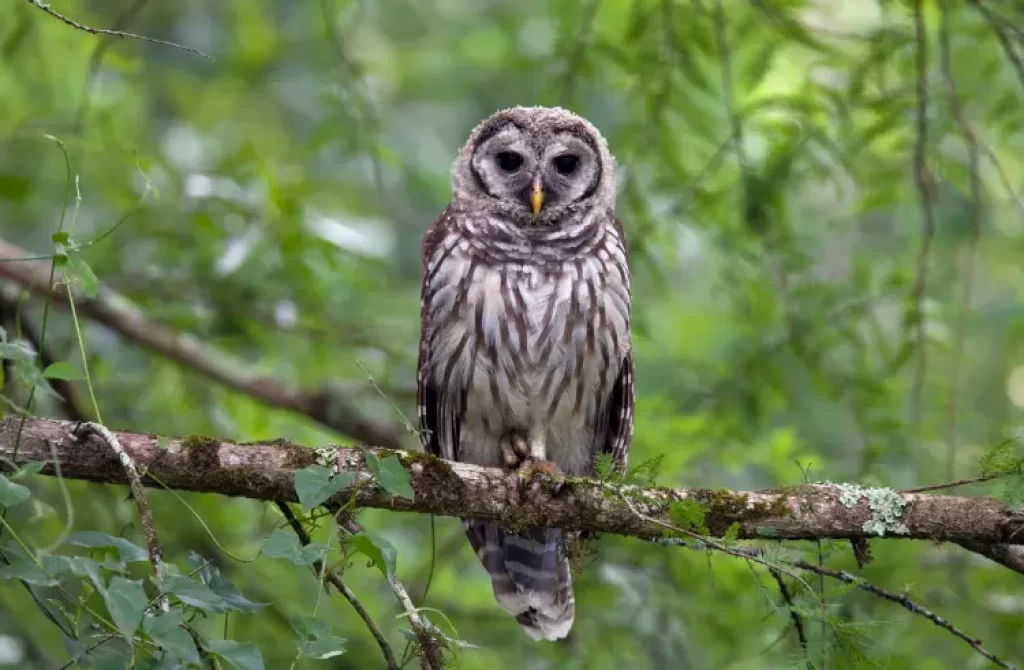
The Barred Owl, with its enchanting hooting call that sounds like it’s asking, “who cooks for you?” is a woodland favorite in Michigan. These medium-sized owls are often found in the state’s dense forests, pickerel lakeshores, and the pristine Pigeon River Country.
Their remarkable adaptability to various forested habitats makes them relatively easy to spot, especially for those with a keen ear for their distinctive vocalizations.
These owls have a penchant for dense woodlands, where their plumage, characterized by striking barred patterns, provides excellent camouflage.
To catch sight of a Barred Owl, explore the lush woods and tranquil lakeshores that are prevalent in Michigan’s landscape.
Listen for their unmistakable call echoing through the trees, and you just might get the chance to witness one of these captivating owls perched in their woodland domain, silently watching over the wilderness.
4. Eastern Screech Owl (Megascops asio)
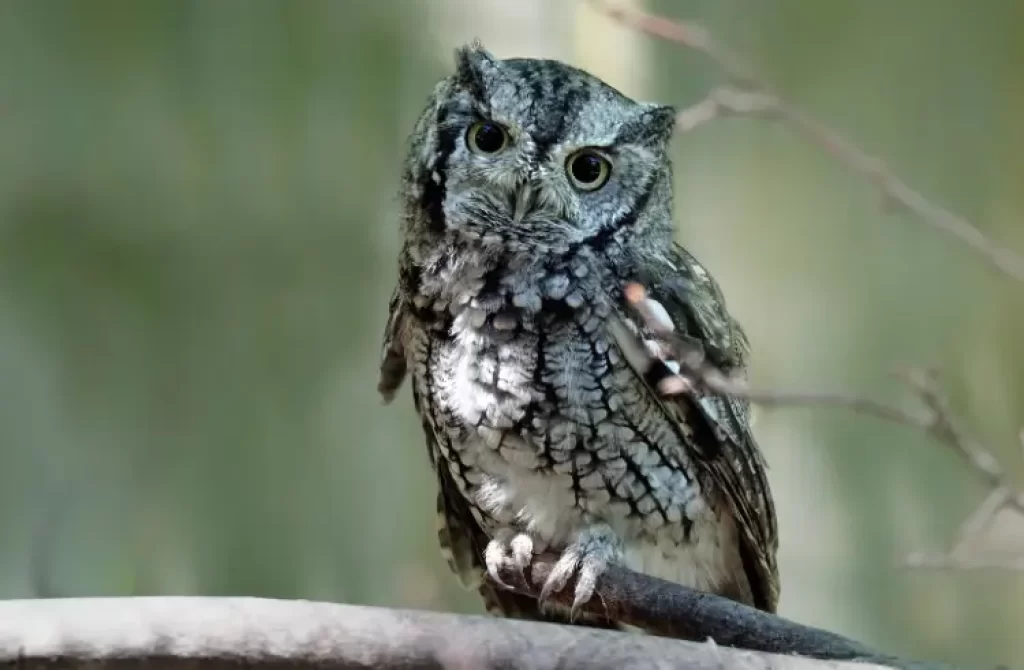
The Eastern Screech Owl, a small and elusive species, adds charm to Michigan’s diverse owl population. Recognizable by its distinctive ear tufts, these owls are known for their petite size and vibrant plumage, which can be red or gray, providing them with excellent camouflage among the woodlands and suburban areas they call home.
Despite their diminutive stature, Eastern Screech Owls are skilled hunters and adapt well to living in close proximity to humans. They often take up residence in suburban neighborhoods, where they nest in tree cavities, providing excellent pest control by preying on rodents and insects.
Fun Fact: The Eastern Screech Owl may be small, but it has a big voice! Despite its size, its distinctive call can carry for miles through the woodlands and suburban areas of Michigan.
To spot these fascinating owls, explore wooded areas, parks, and even your own neighborhood. Listen for their eerie, trilling calls that are often heard after dusk, and you may be rewarded with a glimpse of these charismatic, pint-sized predators.
5. Barn Owl (Tyto alba)
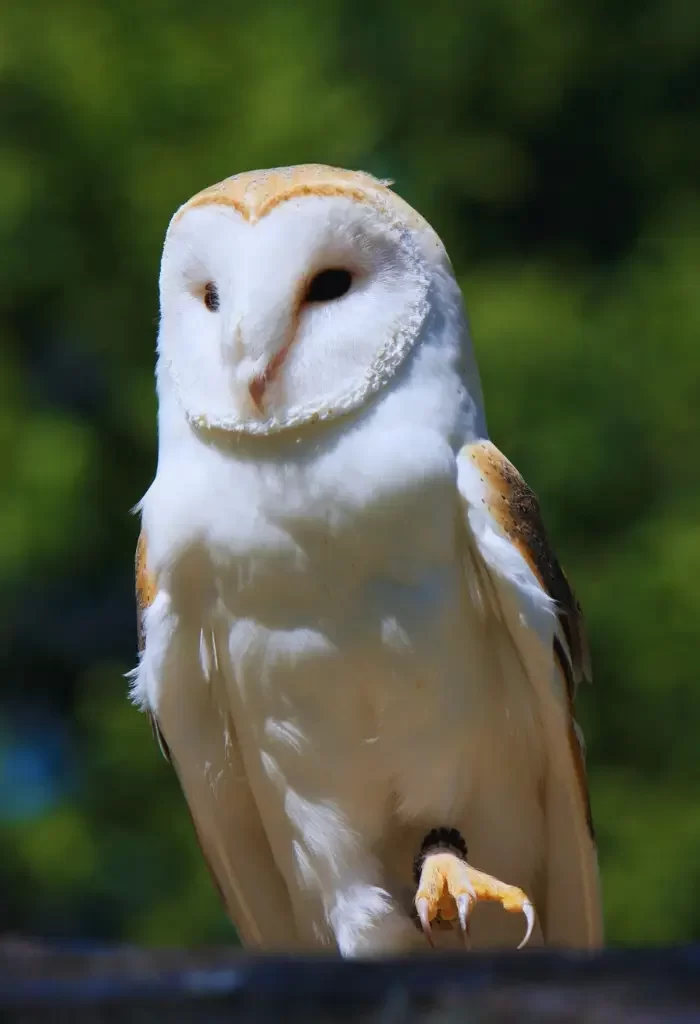
One of the most distinguishable and enigmatic owl species in Michigan is the Barn Owl, characterized by its heart-shaped facial disk. These magnificent birds are known for their ghostly appearance and striking white feathers. Unlike many other owls, Barn Owls are primarily nocturnal and are seldom seen during daylight hours.
Barn Owls often make their homes in open habitats such as grasslands, agricultural areas, and abandoned buildings, making them a unique addition to Michigan’s owl community. They are skilled hunters, relying on their exceptional hearing to locate prey like rodents and small mammals, even in complete darkness.
To catch a glimpse of a Barn Owl, explore rural farmlands and open fields during the evening hours. Listen for their eerie, high-pitched screeches, a distinct sound that adds an air of mystery to the night in the countryside.
6. Northern Saw-whet Owl (Aegolius acadicus)
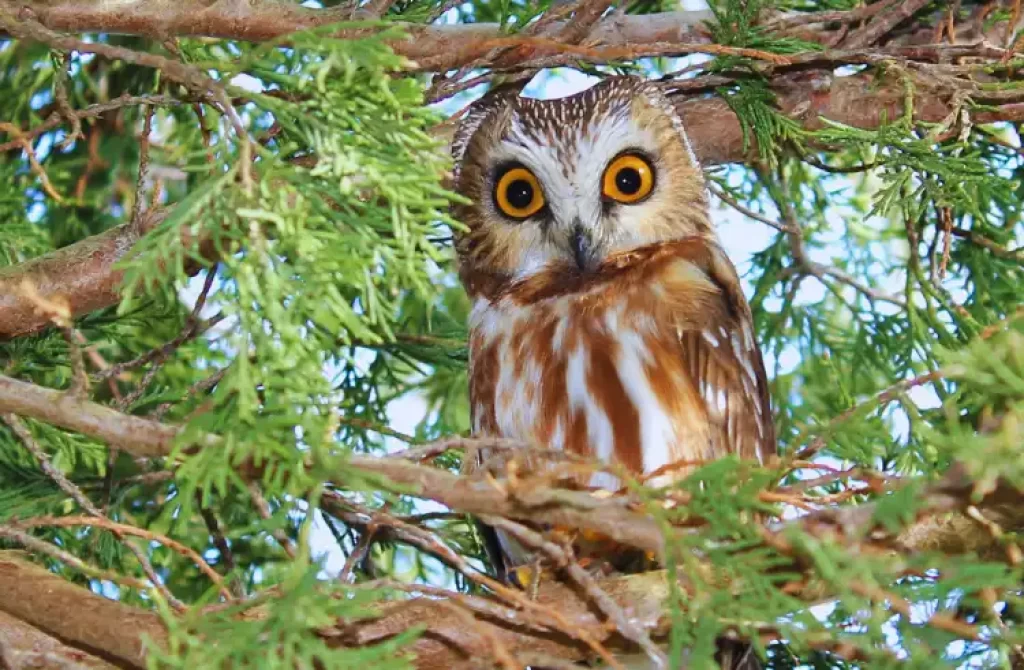
The Northern Saw-whet Owl, one of the smallest owl species in Michigan, is a charming and elusive bird to encounter.
These petite owls typically inhabit woodlands and dense coniferous forests, where their cryptic plumage helps them blend seamlessly with their surroundings.
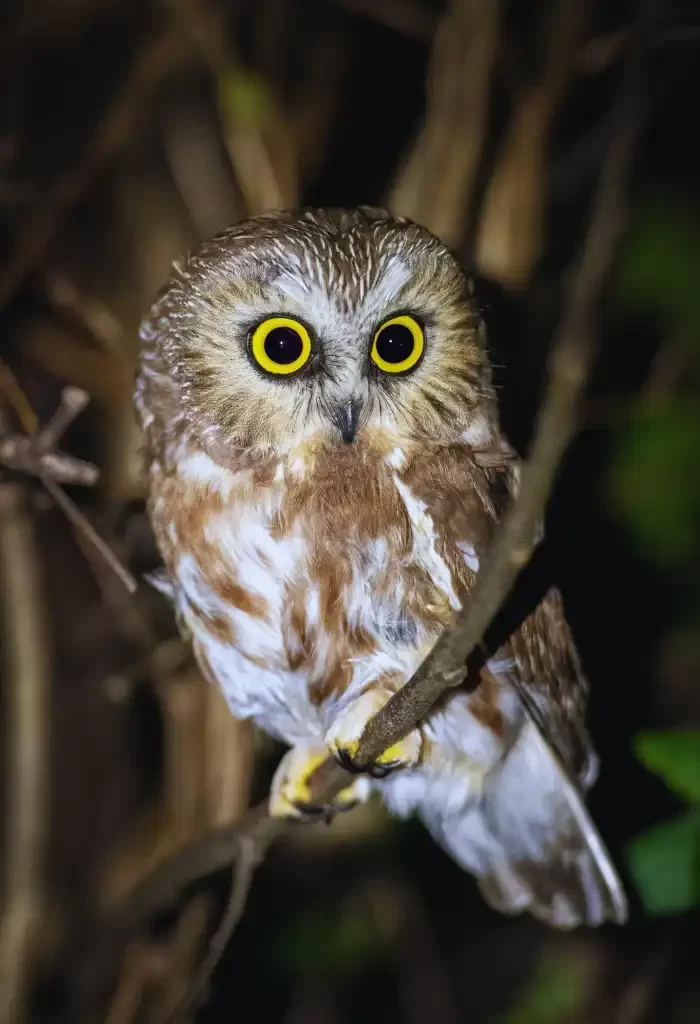
Measuring just about 7-8 inches in length, these owls are known for their small size and big eyes, which are disproportionately large for their petite bodies.
Fun Fact: The Northern Saw-whet Owl is named after its unique call, which sounds like the sharpening of a saw! This tiny owl’s vocalization can be quite surprising when heard in the quiet forests of Michigan.
To spot a Northern Saw-whet Owl, venture into coniferous forests or wooded areas during the twilight hours. Listen for their distinctive calls and keep a keen eye out for these diminutive and delightful creatures roosting in the branches.
7. Long-eared Owl (Asio otus)
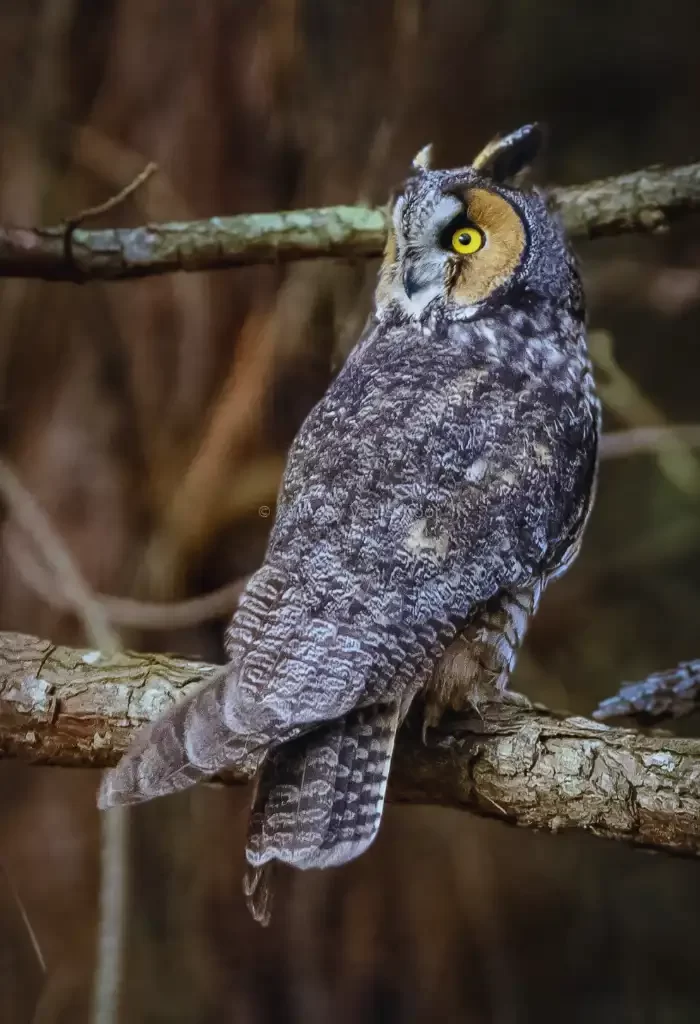
The Long-eared Owl, aptly named for its prominent ear tufts, is an occasional visitor to wooded areas in Michigan, with sightings reported in locations like Tawas Point State Park. Although not as commonly encountered as some other owl species, spotting a Long-eared Owl can be a rewarding experience for bird enthusiasts.
These medium-sized owls are known for their distinctive appearance, characterized by their long, slender bodies and striking ear tufts. Their plumage features mottled brown and streaked patterns, providing excellent camouflage amidst tree branches.
To catch a glimpse of the Long-eared Owl, explore wooded habitats, especially during the winter months, when they may venture southward in search of food. Their elusive nature makes sightings a special treat for dedicated birdwatchers.
8. Short-eared Owl (Asio flammeus)
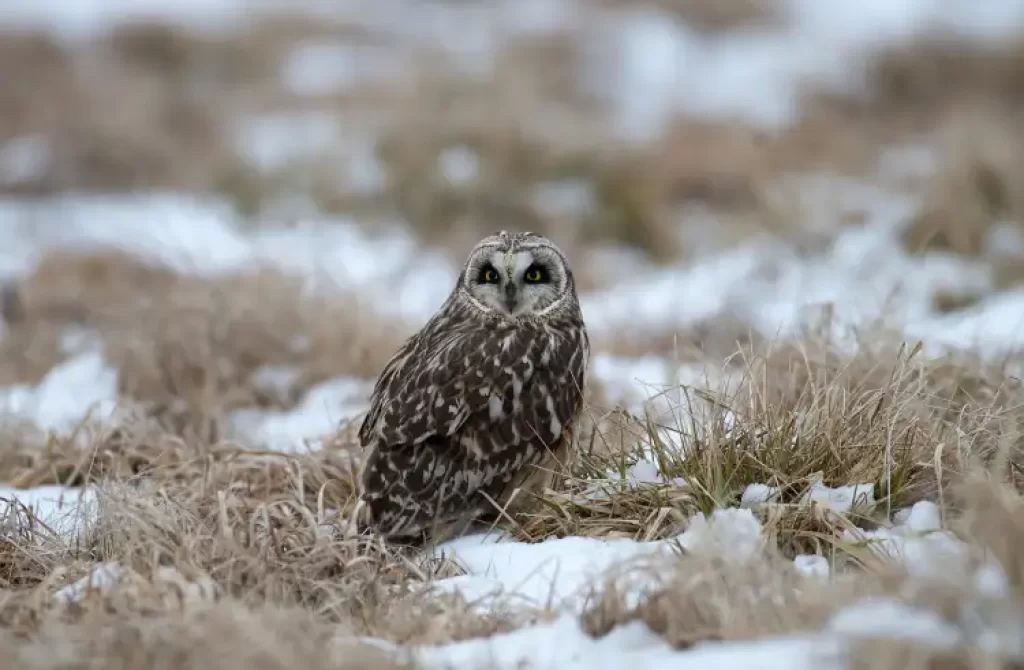
The Short-eared Owl is a diurnal owl species known for its distinctive hunting behavior over grasslands and wetlands. For those interested in observing these owls in their natural habitat, Seney National Wildlife Refuge is an ideal spot.
Unlike many other owls, Short-eared Owls are often active during daylight hours, making them more accessible to birdwatchers. They can be recognized by their mottled brown plumage and distinctive facial disk, though they lack prominent ear tufts.
To increase your chances of encountering Short-eared Owls, visit open areas like grasslands, marshes, and wetlands, especially during the winter months when they may be more visible. With their unique hunting style and diurnal habits, these owls offer a captivating sight for wildlife enthusiasts.
9. Northern Pygmy Owl (Glaucidium californicum)
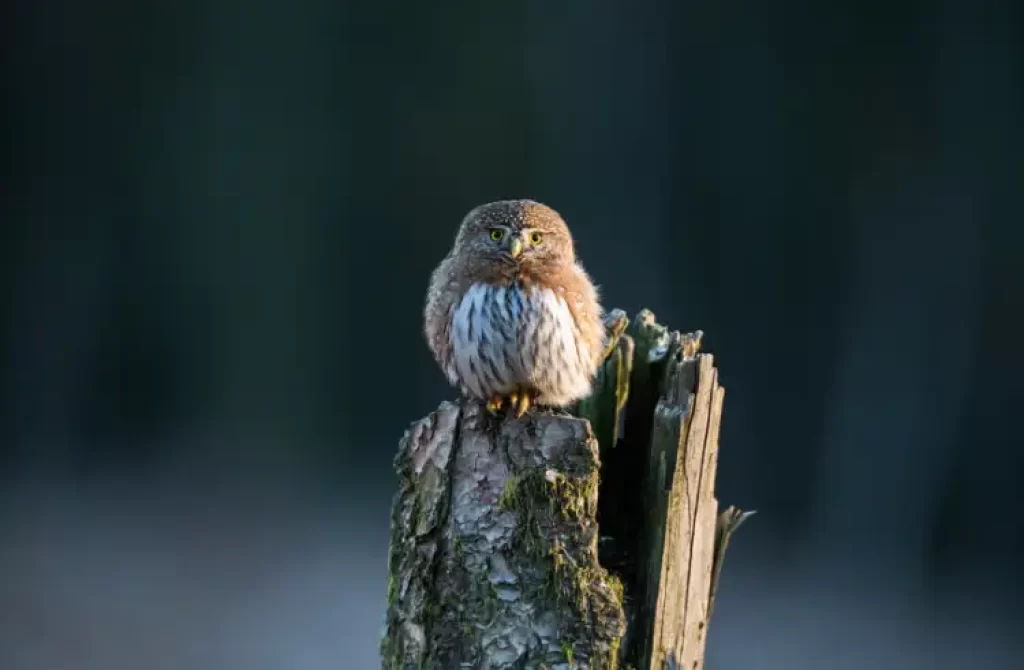
The Northern Pygmy Owl may be small in size, but it possesses a fearless and determined nature. Recognizable by its striking facial pattern and diminutive stature, this owl is a fascinating find in Michigan’s coniferous forests and mixed woodlands.
With its preference for densely vegetated areas, the Northern Pygmy Owl can be observed in locations where it can easily blend into its surroundings. These owls are known for their territorial behavior and may even stand their ground when confronted by larger birds.
Birdwatchers seeking to spot this tiny yet fierce owl should explore coniferous forests and mixed woodlands, paying close attention to their distinct calls, which can help lead to an exciting encounter with this remarkable species.
10. Northern Hawk Owl (Surnia ulula)
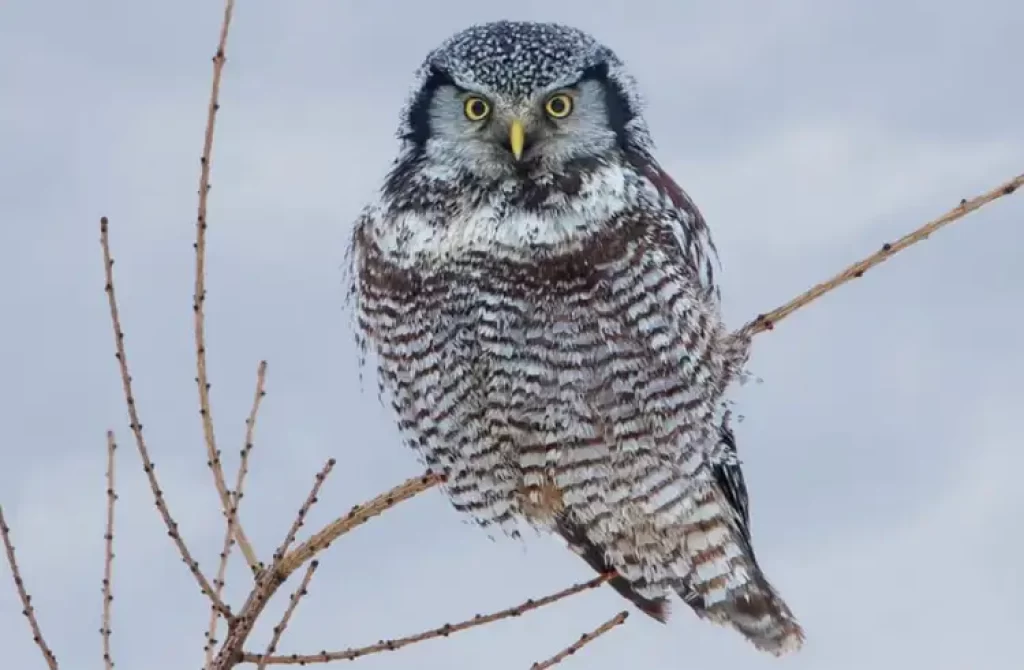
The Northern Pygmy Owl may be small in size, but it possesses a fearless and determined nature. Recognizable by its striking facial pattern and diminutive stature, this owl is a fascinating find in Michigan’s coniferous forests and mixed woodlands.
With its preference for densely vegetated areas, the Northern Pygmy Owl can be observed in locations where it can easily blend into its surroundings. These owls are known for their territorial behavior and may even stand their ground when confronted by larger birds.
Birdwatchers seeking to spot this tiny yet fierce owl should explore coniferous forests and mixed woodlands, paying close attention to their distinct calls, which can help lead to an exciting encounter with this remarkable species.
11. Burrowing Owl (Athene cunicularia)
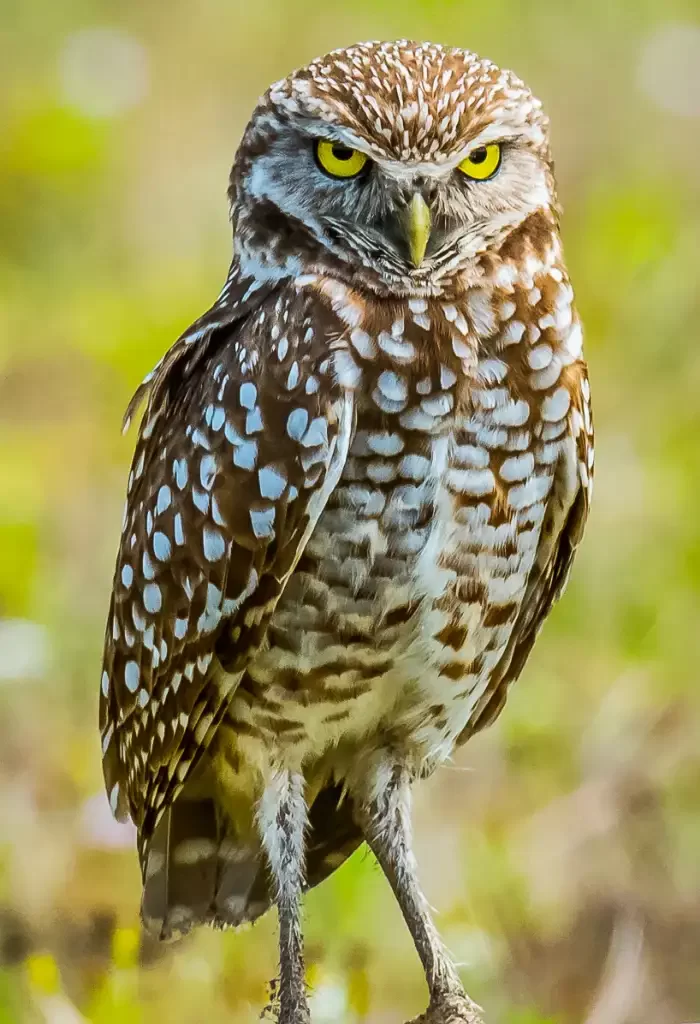
The Burrowing Owl, as the name suggests, is known for its unique nesting habits. Unlike most owls that nest in trees, this owl prefers to nest in burrows, often repurposing burrows dug by other animals.
To catch a glimpse of these fascinating owls in Michigan, head to open habitats and grasslands. Keep a watchful eye on the ground, as you might spot them near their burrows or perched on nearby objects.
Their distinctive appearance and burrowing behavior make the Burrowing Owl a captivating find for birdwatchers exploring Michigan’s diverse avian population.
12. Western Screech Owl (Megascops kennicottii)
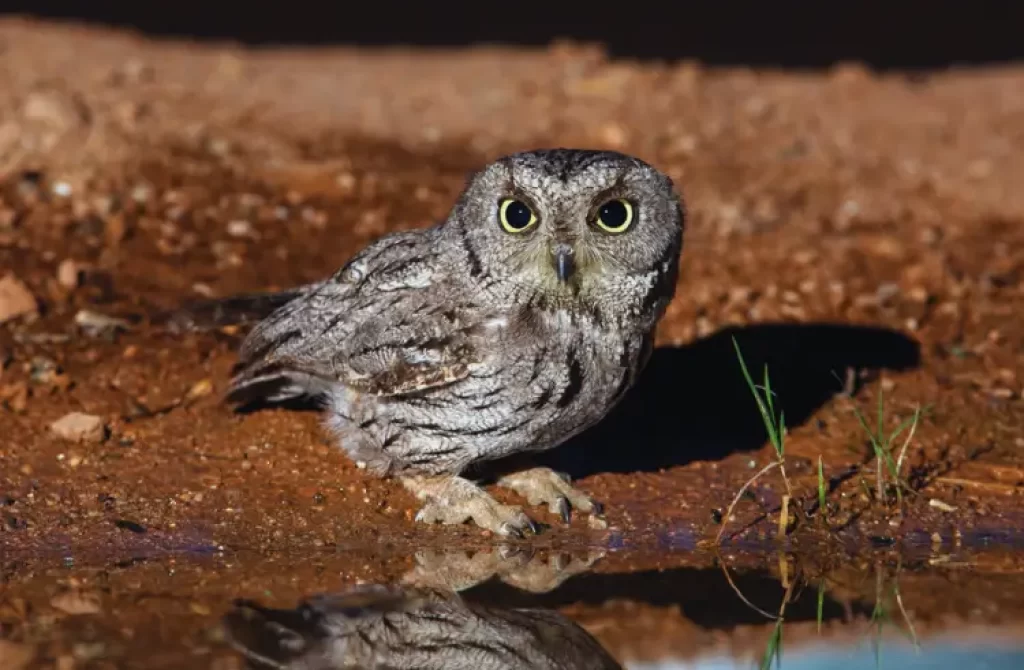
The Western Screech Owl is a close relative of the Eastern Screech Owl, sharing many of its characteristics. These small and elusive owls are known for their distinctive ear tufts and compact size.
To spot the Western Screech Owl in Michigan, explore woodlands and suburban areas, particularly where there are mature trees and suitable nesting sites. These owls can blend seamlessly into their surroundings, so a keen eye and a good pair of binoculars may be necessary for a successful sighting.
Witnessing the Western Screech Owl in its natural habitat is a rewarding experience for bird enthusiasts seeking to appreciate the diversity of Michigan’s owl species.
13. Flammulated Owl (Psiloscops flammeolus)
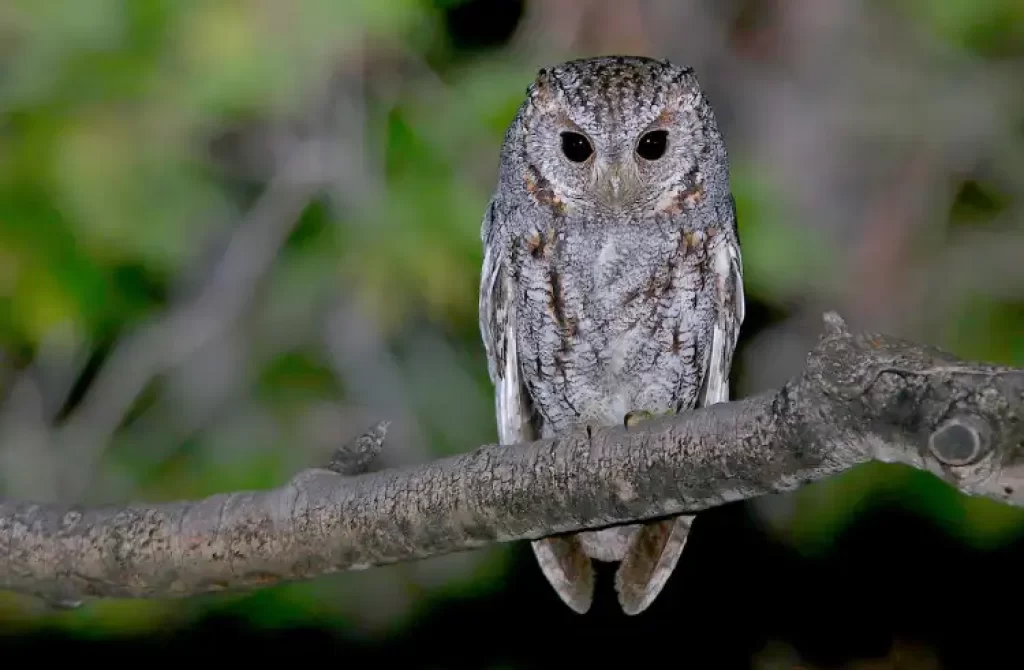
The Flammulated Owl (Psiloscops flammeolus) is a fascinating and cryptic species known for its distinctive appearance and choice of habitat. These small owls derive their name from the flame-like markings present on their plumage, making them stand out among Michigan’s owl population.
Flammulated Owls are relatively small with a length of around 6 to 7 inches. Their cryptic appearance features mottled brown plumage, helping them blend seamlessly into the pine and coniferous forests they inhabit. This camouflage makes them challenging to spot, even for seasoned birdwatchers.
These owls have a strong preference for pine and coniferous forests, where they can easily hide among the dense tree cover. Michigan provides suitable habitat for Flammulated Owls in certain regions with the right forest types.
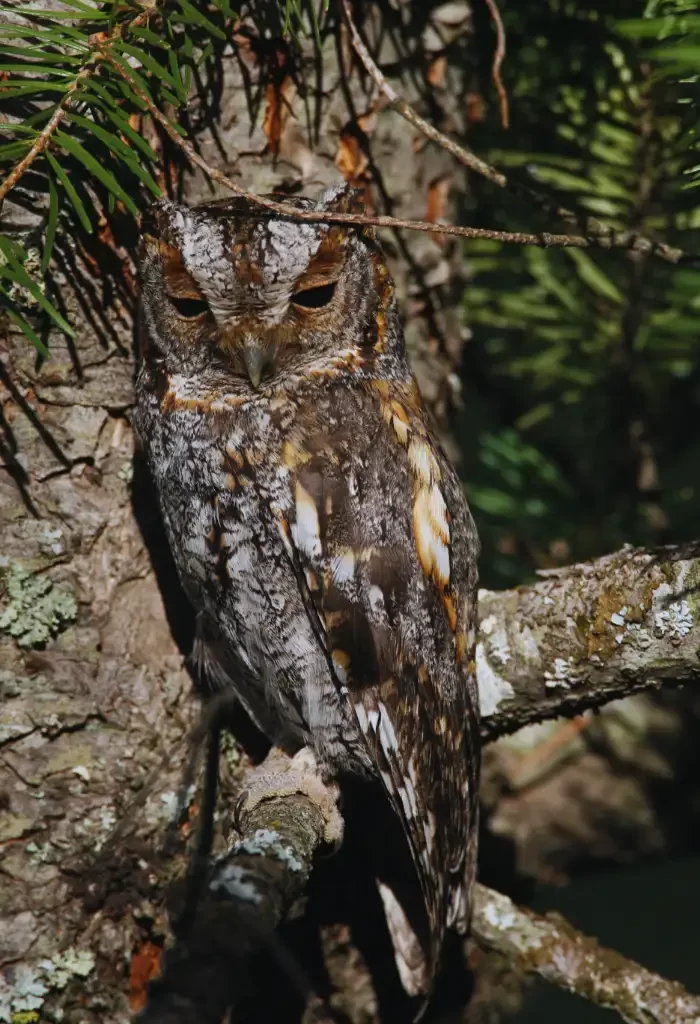
Flammulated Owls are primarily nocturnal, and their calls are typically heard during the night. They have a diet that includes insects, particularly moths, which they catch on the wing during their nightly hunts.
Fun Fact: The Flammulated Owl is a master of camouflage with its cryptic appearance. Its feather markings resemble flames, which makes it a striking and unique addition to Michigan’s owl species.
To observe Flammulated Owls in Michigan, you’ll need to venture into areas with suitable coniferous and pine forests. Be prepared for patient and attentive birdwatching, as these owls are masters of concealment. Listen for their distinctive calls during the night to increase your chances of spotting them.
FAQ
What type of owls are in southeast Michigan?
In Southeast Michigan, you can find several owl species, including the Great Horned Owl, Eastern Screech Owl, Barred Owl, and occasionally the Northern Saw-whet Owl. These owls inhabit a range of habitats, from woodlands and forests to urban areas.
😉 Southeast Michigan offers excellent opportunities for owl enthusiasts to spot these captivating birds!
What’s the biggest owl in Michigan?
The Great Horned Owl (Bubo virginianus) is the largest owl species in Michigan. These impressive birds can have a wingspan of up to 5 feet and are known for their distinctive tufted “horns” and deep hooting calls.
What is the largest owl in northern Michigan?
The largest owl in northern Michigan, as well as in the entire state, is the Great Horned Owl (Bubo virginianus). These owls are known for their impressive size, with a wingspan that can reach up to 5 feet.
Are there owls in Detroit?
Yes, owls can be found in Detroit, Michigan. While Detroit is an urban area, it is still part of a larger ecosystem that includes parks, green spaces, and natural areas where owls can thrive. Great Horned Owls and Eastern Screech Owls, for example, are among the owl species that have been observed in urban and suburban environments, including Detroit.
How rare is it to see a white owl in Michigan?
Seeing a white owl in Michigan, such as a snowy owl, is not an everyday occurrence but is not extremely rare during the winter months. Snowy owls are known to migrate to Michigan from their Arctic breeding grounds, and they are more commonly seen in the state during the winter.
However, the frequency of sightings can vary from year to year, depending on factors like the availability of food and other environmental conditions. Birdwatchers and enthusiasts often keep an eye out for these beautiful birds during the winter season, increasing the chances of spotting them in suitable habitats.
Kenno Marques is a self-taught English speaker deeply passionate about nature and wildlife. He dedicates his time to scouring the web for the latest animal news and engaging content, which he shares on various websites. Fluent in three languages, Kenno is currently on a journey to master German. His commitment to fostering an understanding of the natural world makes him a valuable contributor to the online community.





